Reproduction in Plants: Class 7 Science NCERT Chapter 12
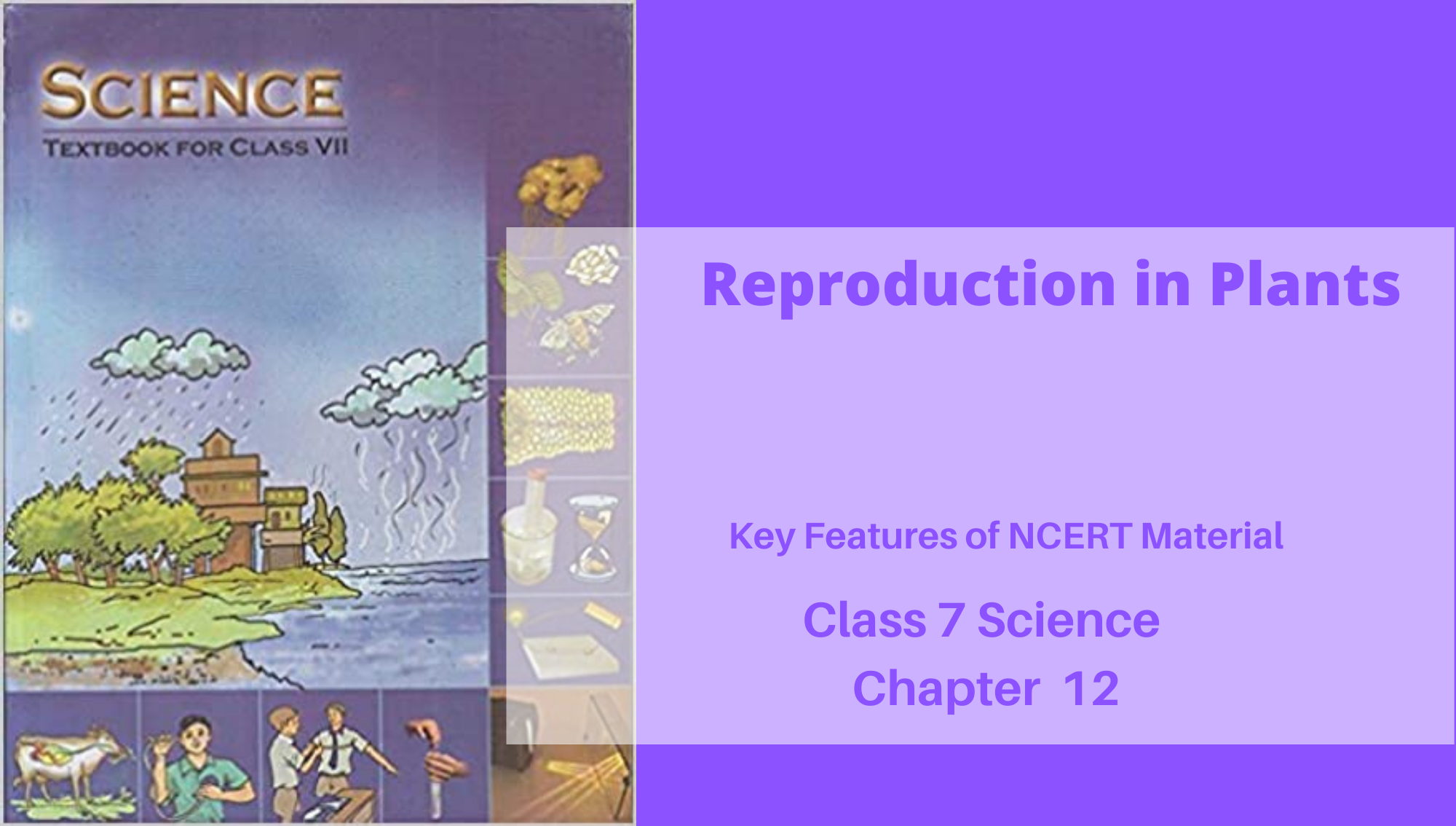
Key Features of NCERT Material for Class 7 Science Chapter 12 – Reproduction in Plants
In the last chapter 11, you learned about transportation in plants and animals. In this chapter, you will get to know about reproduction plants.
Quick revision notes
All the living organisms including plants and animals have the capability to produce new individuals during their lifespan. This process of producing a new organism from the existing organism (or the parent) of the same species is called reproduction. The new individuals produced, are the copies of their parents. The process of reproduction is one of the important life processes and is essential for the continuity of the species.
Thus, reproduction makes the life continuous which is not only essential for the survival of an organism but it is also very necessary for the perpetuation and preservation of the species because it increases the number of members of a species.
Modes of Reproduction
The various parts of a plant such as roots stem and leaves each with a specific function is called vegetative parts. After a certain period of growth, plants bear flowers. These flowers develop into fruits and seeds.
The parts of a plant that participate in the process of sexual reproduction are called reproductive parts or organs. In plants, the reproductive parts are a flower which may have the male or female part or both the parts on the same flower.
Different organisms reproduce in a different way. In plants, there are two different methods of reproduction:
- Asexual reproduction
- Sexual reproduction
The term ‘sexual’ means involving the fusion of sex cells or gametes while ‘asexual’ means without involving the fusion of gametes.
Asexual Reproduction
The process in which only one parent is involved in the production of new individuals of the same kind is called asexual reproduction. In plants, asexual reproduction results in the formation of offsprings or new plants without seeds or spores.
Asexual reproduction in plants occurs through the following methods:
- Vegetative propagation
- Budding
- Fragmentation
- Spore formation
- Vegetative Propagation
It is the development of new plants from vegetative units of bud, stem, and so forth. These vegetative units are called propagules. Vegetative reproduction may occur utilizing different plant parts as given underneath:
(I) Vegetative Reproduction by Stem
The stems or parts of the plant ordinarily bear buds in the axils. The buds that are available in the axil (for example the purpose of connection of leaf at the hub) forms into the shoot. These are called vegetative buds.
The vegetative buds can offer ascent to another plant. These buds comprise of a short stem around which juvenile covering leaves are collapsed. These can create another plant by vegetative engendering.
Techniques to Vegetative Reproduction by Stem
(I) New plants are acquired from the stem by the cutting strategy. In this strategy, the little some portion of stem is taken out by making a cut with a sharp blade. The stem cutting must have a few buds on it. Presently the lower end of stem cutting is covered in the wet soil. The upper piece of cutting having bud on it, is kept over the dirt. Following scarcely any days, this cutting grows new roots. The bud develops and creates a shoot
(for example branches with leaves). Accordingly, another plant is delivered which is actually like the parent plant, for example rose, champa, grapes, sugarcane, banana, desert flora, and so on.
(ii) Another strategy for vegetative reproduction in stem is by layering. In this strategy, a develop part of parent plant is twisted down and secured with soil. The tip of the plant is kept over the ground. The root creates from the branches and develops into another plant. Layering strategy is typically done in the plants that have long and slim branches, for example jasmine.
(iii) Grafting is likewise a technique for vegetative reproduction in stems, where new plants of wanted characteristics is created from two unique plants. The part that has shoot part is called scion and part having root is called stock. Scion is appended to the stock which offers help and essential necessity for the advancement of plant, for example apple, mango, rose, and so forth.
(ii) Vegetative Reproduction by Leaves
At the point when the leaf of certain plants are rushed into the soggy soil, the cut edges or edges of leaves build up another plants that take after to the parent, for example Bryopbyllum or fledgling leaf plant.
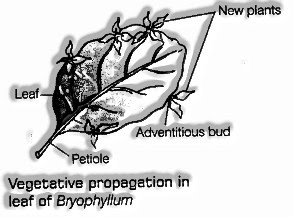
(iii) Vegetative Reproduction by Roots and Bulbs
In certain plants like yam, dahlia, and so forth, another plant creates through their underlying foundations and bulbs.
Note: Plants like desert flora delivers new plants when their parts get disengaged from the primary plant body. Each isolates part can develop into another plant.
Points of interest of Vegetative Propagation
Plants delivered with vegetative reproduction sets aside less effort to develop and bear bloom and organic products sooner than those created from seeds.
The new plants are the precise of parent plant since they are delivered from a solitary parent.
- Growing
In this cycle, a girl individual is framed from a little projection on parent body called a bud. The greater part of the growths like, yeast duplicate by sprouting.
Yeast develop and duplicate in at regular intervals, whenever furnished with adequate supplements and ideal condition.
- Fracture
Some green growth (Spirogyra) that are available in waterbodies repeat by fracture. In this-strategy, the body of the parent breaks into little pieces called sections and each part grows up to turn into another plant. Fracture of parent body happens when they are developed.
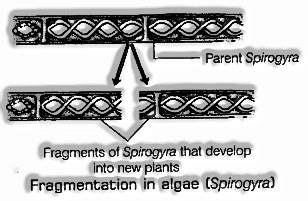
If water and nutrient are available, the algae will grow and multiply rapidly by fragmentation. If this process continues, it will cover a large area in a very short period of time.
- Spore Formation
Some fungus like bread mould reproduces asexually by spore formation. Spores (present in the air) are the small spherical bodies, having a thick protective wall that protects them from unfavourable conditions. When favourable conditions arrive the spores burst and germinate to develop into new plants.
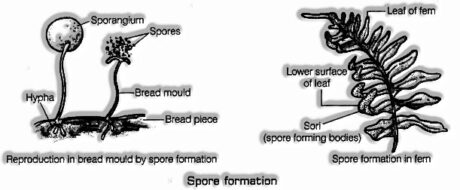
Spores are extremely light asexually duplicating bodies which can be extended a significant distance via air or wind. Some different plants like greeneries and plants likewise recreate by spore development in the underside of their leaves.
Sexual Reproduction
Blossoms are the regenerative aspect of a plant. They help the plants in sexual reproduction and creating products of the soil. In sexual reproduction, a male cell is delivered by the male aspect of a blossom which wires with a female cell created by the female aspect of the bloom. These phones are called gametes, which when consolidated structure a zygote by the cycle called treatment.
Portions of a Flower
The principle parts of a blossom are
(I) Sepals These are the green leaf-like peripheral hover of the blossom. All the sepals are together alluded to as calyx. The capacity of the calyx is to ensure the blossom when it is in bud structure.
(ii) Petals These are the brilliant and most alluring aspect of the blossom. These lie inside the sepals. All the petals are together alluded to as corolla. These are scented and draw in creepy crawlies for fertilization.
(iii) Stamen It is a male conceptive organ of a plant. These are the little stalks with swollen top and lies inside the ring of petals. The stamen is comprised of two sections, for example fiber and another. The tail of stamen is called fiber and the swollen head of stamen is called anther.
The anther contains the dust grain which have male gamete in it. Dust grains are uncovered when the anther matures and parts. These show up as the yellow powder like substance which is clingy in nature. Blossoms ordinarily have various stamens in it.
(iv) Pistil It is the female conceptive aspect of a bloom that lies in the focal point of a blossom. These are a flagon formed structure which is comprised of three sections, for example disgrace, style and ovary.
The top aspect of the pistil is called shame. It gets the dust grains from the anther during fertilization. The center aspect of the pistil is tube-like structure called style which associates shame to the ovary.
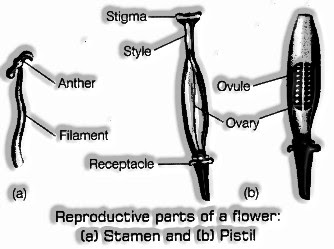
The swollen base part at the base of pistil is called ovary. The ovary makes ovules and stores them. These ovules contain the female sex cells additionally called an egg cell. It is the female gamete of bloom. Pistil is additionally called as carpel. The pistil is encircled by a few stamens.
The base of the blossom on which all the pieces of the bloom are appended is called repository.
Kinds of Flower
Based on the kind of regenerative organs present in a rose, the blossoms are of following sorts:
(I) Unisexual bloom: The blossom which contains just a single regenerative organ (for example either male or female) are called unisexual blossoms. These are additionally called as a deficient blossom, for example papaya, watermelon, corn, cucumber, and so forth.
(ii) Bisexual blossom: The bloom that contains both regenerative parts (for example male and female) in a solitary blossom are known as an androgynous bloom. These are likewise named as bisexuals or complete bloom, for example rose, mustard, Hibiscus, and so forth.
Capacity of a Flower
The capacity of a blossom is to make male and female gametes and furthermore to guarantee that preparation would happen for the seed development. During sexual reproduction male and female gametes breaker to shape the zygote.
Fertilization
The exchange of dust grains from the anther of a stamen to the disgrace of a pistil is called fertilization. Fertilization happens in two distinct manners:
(I) Self-fertilization: When the dust grain from the anther of one blossom compasses to the disgrace of the equivalent ‘ bloom, it is called self-fertilization. Self-fertilization by and large happens in a swinger bloom.
(ii) Cross-fertilization: When the dust grains from the anther of a bloom or of a plant are moved to the disgrace of a blossom of a similar plant or that of an alternate plant of a similar kind the cycle is called cross-fertilization. This exchange to another plant is interceded by bugs, wind, water, creatures, fowls, and so on.
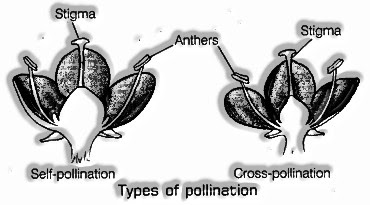
Specialists of Pollination
The cycle of fertilization is completed by some outer organizations like breeze, water, creepy crawlies, winged animals, and so on. These are called specialists of fertilization.
Preparation
The cycle where the male gamete wires with the female gamete to shape another phone (called zygote) is called treatment.
At the point when the dusts are kept on the shame of the gun, it starts to develop. After some time, a long dust tube is created from the dust grain which goes through the style towards the female gametes in the ovary. The male gametes descend the dust tube and the cylinder enters the ovule present inside the ovary.
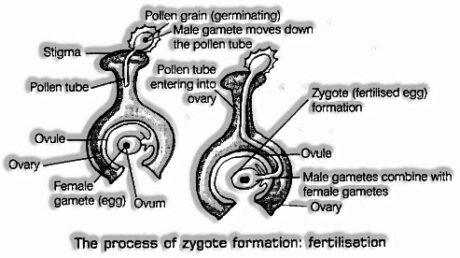
The tip of dust tube blasts and the male gamete emerges from the dust tube. Inside the ovary, the male gametes combine with the female gametes present in the ovule to frame a treated egg cell which is called zygote.
The zygote forms into an incipient organism which is an aspect of a seed that forms into another plant.
Products of the soil Formation
After the preparation, the ovary develops into the foods grown from the ground ovule forms into the seeds. The external pieces of the blossom, for example petals, sepals and stamen become get and fall dry. Shame and style additionally tumble off leaving ovary on the repository. The zygote inside the ovary gets its food from the ovule and develops by cell division to frame an incipient organism. Portions of the ovule form into the seed covering or seed coat.
Natural products are the aged ovary of a bloom. Which ensure the seed. A few organic products are beefy and succulent, for example mango, apple and orange, while some are hard similar to almonds and pecans.
Seed Dispersal
Seeds are created from the ovule. Seeds contain an incipient organism encased in a defensive seed coat. Plants produce countless seeds. At the point when these seeds tumble down, they begin developing. In the event that an enormous number of seeds falls on a similar spot, they won’t get enough space for water and light, and won’t form into a solid plant. Hence, the seeds are moved away by some outer organizations to distant spots.
The cycle by which the seeds are dissipated to better places (all over from their folks) is called dispersal. The seeds and natural products are scattered away through different organizations like breeze, water, flying creatures and a few creatures. At some point seed dispersal happens normally by the blast or blasting of organic products.
Seed Dispersing Agents
Wind, water, creatures, winged animals and people are the scattering specialists of seeds. These are depicted underneath:
Dispersal by Wind or Air
The seeds that are light and have wing or hair-like structure on them, are effortlessly diverted by the blowing wind, for example seeds of maple, drumstick have wings, seeds of Madar or oak have hairs on them, cottonseed likewise have hairs on them, while seeds of grasses, orchids, begonia are little and light. These seeds can be effectively diverted by the breeze and scattered away from their regular natural surroundings.
Dispersal by Water
The seeds of certain plants that have an external sinewy or springy covering are scattered through water. They can skim in the water and float alongside its stream, for example seeds of water lily, lotus, chestnut (singhara) and coconut are scattered through water. The coconut natural products have a stringy external coat which empowers them to skim in water and diverted by streaming water to far away places.
Dispersal by Birds
The feathered creatures eat natural products alongside the seeds. These seeds have hard external covering. The seeds are scattered to some other spot through the fowl’s excrement. The stomach related chemicals present in the stomach related arrangement of flying creatures helps in dissolving the hard seed coat and when they are delivered or discharged alongside the dung, they sprout, for example neem seeds are scattered by the feathered creature’s excrement.
Dispersal by Animals
A few seeds have snares or spines which get appended to the hide or body of the touching creatures. At the point when these creatures move to a removed spot, the seeds get scattered (while creature rub their body surface), for example product of Xantbium and Urena plants are secured by various snares which connect to the creature’s hide and are scattered with them. Alongside the organic products, the seeds likewise get scattered.
Dispersal by Explosion or Bursting of Fruits
Once in a while natural products develop and a strain is delivered in their dividers. This creates an unexpected twitch making natural products tear open, accordingly permitting the seeds to disperse far away from their parent plants. Because of the blast of organic product, the seeds are discarded from the plant with an extraordinary power toward all path, for example castor plant burst unexpectedly with a yank and dissipate the seeds far away from the parent plant. Thus, product of amber is likewise scattered through the blast component.
Advantages of Seed Dispersals
Seed dispersal abstains from congestion of youthful plants around their parent plants.
It helps in forestalling rivalry between the plants and its own seedlings for daylight, water and minerals.
One of the advantages of seed dispersal is that it empowers the plant to develop into new natural surroundings for more extensive conveyance and gives them a superior possibility of endurance.
Germination of Seed
A seed contains a plant undeveloped organism in a resting state which start to become distinctly under ideal conditions. The cycle by which seeds start to develop is called seed germination. It is the development of a plant from its seed. At the point when the seed sprouts, the seed coat parts and a minuscule root called radicle becomes descending and shoot called plumule begins developing upwards. This produces seedling of the plant.
The seedling becomes quicker and at last structures another plant. At the point when the plant begins developing, it bears blossom which again delivers seed and organic products. This cycle keeps on creating more offsprings for the conservation of an animal groups.

